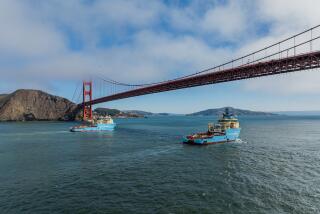Beach’s Dirty Little Secret
TOKYO — It’s Tokyo’s premier beach -- a strip of wave-washed sand carefully constructed more than a decade ago in a multimillion-dollar project to give Japan’s sprawling capital an ultramodern waterfront.
But the city has a warning to visitors: Don’t swim. Don’t even wade. And it might be best to cover your nose.
It turns out that those waves are washing the beach with human waste, thanks to sewage plants upstream that spill their contents into Tokyo Bay whenever they are inundated by heavy rain.
“I never let my kids splash around here,” said Hiromi Tanaka, 33, a housewife shopping at the beachside mall with her two toddlers. “The water is pretty gross.”
To many, the beach’s problems are symbolic of what ails Tokyo itself.
The environment took a beating in the rush to rebuild Japan’s capital after World War II as priorities were instead focused on simply providing homes. The economic boom then led to a building spree that was largely unbridled by zoning restrictions and left the city with a legacy of eyesores.
As Tokyo grew, lurching from 3.5 million people in 1945 to 10 million in 1962, urban planners raced to catch up. Only in 1995 did the sewage system effectively reach all of the city’s 23 wards.
The sewage problem has yet to be solved in Odaiba, however.
In a recent study, the city sewage bureau repeatedly found levels of fecal matter at Odaiba Seaside Beach Park above the acceptable maximum. Often, the amount of bacteria was more than 10 times what is considered safe.
Signs prohibiting swimming were posted when the beach first opened. They were updated last summer to make even wading off-limits.
“Unfortunately, environmental concerns have sometimes been left by the wayside as the [bay] area developed,” said Nobuyuki Imamoto, spokesman for the Environment Ministry.
Embarrassed into action and with potential health problems for the 1.6 million visitors to Odaiba each year, the government has launched a $6.8-million cleanup effort at the 1,800-foot beach, which was reclaimed from the sludge of Tokyo Bay in the late 1980s.
A state-of-the-art water-purification plant is set to open in July to suck in the sullied water through a huge underground pipe. After percolating through sand filters and being disinfected with ultraviolet rays, the water will be spewed crystal-clear back onto the beachfront.
A 300-foot floating boom set offshore will help keep the dirty water from seeping back in.
But authorities say little can be done to stop the pollution itself.
“The sewage plants are adhering to government regulations as they stand,” Imamoto said. He conceded that the regulations are probably outdated.
Still, waterfront development around Odaiba is a centerpiece of Tokyo’s urban improvement plans.
Designed to offer a respite from the clogged, drab streets of the city, the Odaiba district features public parks, broad avenues and modern, visually appealing high-rises.
Driverless trains silently sweep people across the bay’s enormous suspension bridge over the beach and deposit them in a high-tech wonderland of virtual-reality theme parks, computerized shopping malls and a huge Ferris wheel.
But development has been snagged by Japan’s lingering economic slowdown. Vacant lots and unfinished transport links are one indication of how it hasn’t sparked the expected windfall for the city’s coffers.
“The common belief was that you couldn’t go wrong in real estate, so they built Odaiba,” said Hiroshi Yamamoto of the Waterfront Vitalization and Environment Research Center, referring to Japan’s speculative property bubble in the 1980s. “Now, that land is lying useless.”
Yamamoto also expressed doubts about whether the beach will ever be fit for swimmers.
“That sewage is still going to float in, no matter what you build,” he said.
More to Read
Sign up for Essential California
The most important California stories and recommendations in your inbox every morning.
You may occasionally receive promotional content from the Los Angeles Times.









